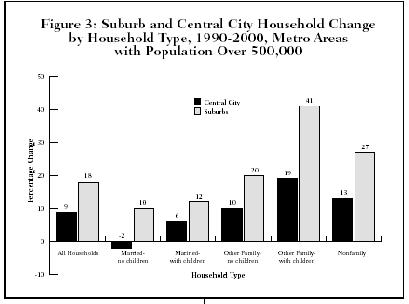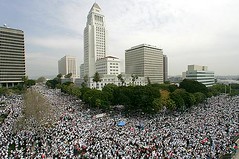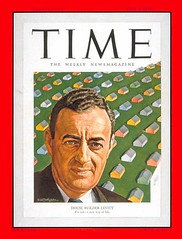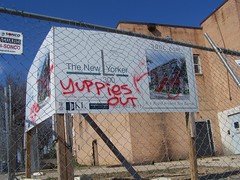It's demography (reaction to City Paper article "Honey, I shrunk the District")
 Suburb and Central City Household Change by Household Type. From Frey and Berube, City Families and Suburban Singles: An Emerging Household Story From Census 2000. For a slightly more readable version of this graph click here.
Suburb and Central City Household Change by Household Type. From Frey and Berube, City Families and Suburban Singles: An Emerging Household Story From Census 2000. For a slightly more readable version of this graph click here.This week's City Paper cover story, "Honey, I Shrunk the District," is about the alleged continued population shrinkage of the District of Columbia.
The article has a cute title but is somewhat misdirected, because "the District's epic population problem," is about broad demographic trends impacting center cities generally, with the particular nuances that come from the strong real estate market in the District of Columbia.
(See this link for DC population figures from 1800-1990.)
I do have some question about the population projections of the Census Bureau, which show a continued leakage of population, in part because in the area where I live, I don't see displacement (that much) but instead the habitation of previously vacant or entirely new housing. But there is no question that larger families continue to move out of the city.
In conversation, Ralph Garboushian pointed out that all through the 1990s, the Census Bureau projected population drops every year, so that around 2000 the population should have been about 520,000. Yet, the Census population figure for 2000 was around 580,000 residents. And each year after the 2000 Census, the Bureau continues to project population shrinkage for DC, despite all the new construction we see going on around us.
The City Paper discusses Census Bureau projections on page 20 of the article, without acknowledging the facts of what happened in the 1990s.
Typically, household (family) size decreases with income, level of educational attainment, and urbanization (urban households tend to be smaller than rural households). This is why countries in Europe, as well as Russia and Japan, are experiencing steep population declines.
Meanwhile the U.S. population continues to increase, even though the country is predominately urban, and U.S. urban households tend to have fewer members compared to rural households. But, the U.S. population continues to grow due to immigration. (cf. and think about the recent pro-immigration rallies across the country, in places ranging from Los Angeles and Dallas to Columbus, Ohio and Boise, Idaho. Millions of people attended these rallies!)
 Thousands protest against House-passed HR 4437, an anti-immigration bill that opponents say will criminalize millions of immigrant families and anyone who comes into contact with them.(Bob Chamberlin / Los Angeles Times) Mar. 25, 2006.
Thousands protest against House-passed HR 4437, an anti-immigration bill that opponents say will criminalize millions of immigrant families and anyone who comes into contact with them.(Bob Chamberlin / Los Angeles Times) Mar. 25, 2006.Something that clouds our understanding of U.S. demography is the post World War II "Baby Boom," which resulted in a burgeoning increase in family size amongst households--higher income, higher education, urban, white--that would not have been expected to have as many children as they did.
The Baby Boomer families fueled suburban outmigration--a multi-decade trend that started in earnest with the mass production of the automobile and the availability of relatively cheap personal transportation. However, outmigration was seriously stunted by The Great Depression.
 Model T Ford, mid-1920s, photo from the Vanatta Brothers webpage.
Model T Ford, mid-1920s, photo from the Vanatta Brothers webpage.With economic strictures removed by the end of World War II and the subsequent postwar economic boom, normal urban demographic trends "were thrown out the window," and outmigration and population surged. Levittown, first on Long Island, and then in the Philadelphia suburbs, is the classic illustration of this.
 Levittown House, 1948.
Levittown House, 1948. William Levitt, the mass production home builder, made the cover of Time Magazine.
William Levitt, the mass production home builder, made the cover of Time Magazine.Frey and Berube point out in their Brookings Institution-published report, City Families and Suburban Singles: An Emerging Household Story From Census 2000 that:
...focusing exclusively on population change offers only a partial picture of metropolitan growth dynamics in the 1990s. Change in the number and composition of households may be a better indicator of changes in metropolitan housing demand, tax base, and services needs than population change.
For instance, in the 1990s the city of Washington, D.C., lost 6% of its population, but the number of households remained relatively stable (1% loss). This implies that, on net, the city lost larger families with children but gained and retained smaller, childless households. Looking at household change and not just population change helps to explain the continued high demand for housing in that city. Washington’s experience, though, is different from that of other cities such as New York, Detroit, Phoenix and Los Angeles. Recent household change dynamics differ sharply across metropolitan areas, reflecting shifting household types and location preferences that are shaping cities and suburbs in new ways. (p.2)
Frey and Berube write further:
This shift in the direction of household-versus-population growth is based on separate demographic forces. The recent declines in household growth are attributable to the smaller post-Boomer generation entering its household formation years in the 1990s. The recent increases in population growth can be attributed in large part to immigrant population waves whose first, second and third generations are living in cities, and have younger age structures and often higher birth rates. In addition, the households these newcomers form are different from those formed in the 1970s by "coming of age" Baby Boomers. Immigrants and children of immigrants are more likely to marry earlier and form larger, married couple with children households.
In the DC region, the central city proper isn't that welcoming to immigrants, because the relative strength of the real estate market, even in "bad times," means that the cost of housing (to buy or to rent) is relatively high, accounting for large agglomerations of immigrants in the suburbs--Arlington, Fairfax, and Montgomery Counties are known for burgeoning Asian and/or Latino clusters, featuring large shopping districts catering to immigrants in their native languages.
I've written about this before in "It appears as if I am becoming a sociologist..." which discusses what sociologists call the invasion-succession theory and the life cycle of neighborhood change.
So there are two issues, one is smaller household sizes, the other is that DC proper is less likely to attract immigrants as residents.
Speaking of smaller household sizes, look at a Census enumeration sheet for an average DC street from the early part of the last century. Houses with maybe one to three residents today may have had as many as 12 people in residence back then.
This Census Enumeration sheet from 1920, for the 800 block of H Street NE and the 700 block of 9th Street NE demonstrates a bit of what I mean, although none of these households was particularly "large"--the biggest shows 6 people in residence--but other than group houses, how many houses on your block today have six (or more) residents?
Plus, back then, on H Street people lived over their stores, whereas that isn't the case today. Click through to view this image at the largest size.
 1920 Census data, H and 9th Streets NE, Washington, DC. THANK YOU to Peter Sefton for this image.
1920 Census data, H and 9th Streets NE, Washington, DC. THANK YOU to Peter Sefton for this image.The City Paper article starts off with a discussion of the relative failure of the DC City Living promotion program (modeled after the best practice example of Live Baltimore). Having exhibited at the one event (and writing two long analyses of the experience), I think that the real "failure" was in the District Government's lack of an investment perspective about the effort.
 H Street Main Street booth at the City Living Expo, 2003. Photo by Kevin Palmer.
H Street Main Street booth at the City Living Expo, 2003. Photo by Kevin Palmer.From the City Paper article:
As it happens, the city was also out of money to spend on it. “We hope to bring the EXPO back in the future should additional resources become available,” Jackson wrote in a letter to the Washington Convention Center Authority. “In the meantime, we will still maintain our presence on the web at www.citylivingdc.com.”
The first year of the “city living” campaign cost the District government upward of $600,000. The campaign was aimed at bringing new residents into Washington—and more specifically, selling housing units—but it didn’t seem to capture the imaginations, or the pocketbooks, of the city’s biggest housing enterprises.
“We never could get Fannie Mae to buy in as a major corporate sponsor. We couldn’t get other ones like a Long & Foster or a Weichert, Realtors,” says Michael Stevens, a top architect of “city living, dc style!” and the former president of the Washington, DC Economic Partnership. “We just could never get those $100,000 sponsors. It was even hard to get $20,000 sponsors.”
One of the major reasons that the District "needs" more residents is because income taxes are the second most important source of "income" for the District Government, after commercial property taxes.
To my way of thinking, rather than whine about how DC couldn't get sponsors to pay for the cost of the program, the "City Living" program should have been conceptualized as an investment and funded accordingly. It's not any different from magazine and newsletter publishers investing in direct mail programs to land subscribers. We all know the dictum, "to make money you have to spend money." Income-tax and property tax paying residents are "good clients" for the Office of Tax and Revenue. It's to the DC government's advantage to attract more revenue paying residents.
The City Paper article then goes on to focus on two major issues:
(1) the resident attraction strategies outlined in the Alice Rivlin paper, "Envisioning a Future Washington," the subsequent choice of a focus on adult households without children, and the social tensions caused in part by the particular focus chosen; and
(2) the fact that lousy public education options, even more than concerns about public safety means that residents with children often choose to leave the District at some point in their household life cycle, in search of better public education options.
It happens I wrote about this in 2003.
I am not going to belabor the "Rivlin strategy paper" but this was my reaction a couple weeks in advance of the City Living Expo event:
This leads to something that concerns me about the Mayor's campaign to attract 100,000 more residents to the City. Obviously, attracting more residents to the city is something we need to do for many reasons -- to increase income tax revenues, to provide more residents -- eyes on the street -- to help stabilize various areas of the city, to provide more people clamoring for high-quality municipal services, etc. But I have some concerns.
First, there is no discussion of this as a “stretch goal” or an ideal. If I remember correctly, the market study performed for the H Street Strategic Development Plan forecasted a demand for about 15,000 units of new housing for the whole city over the next ten years...
and as far as education is concerned it was listed as one of eight other aspects of "City Living" that I thought should be addressed in the creation of a true campaign centered around making the District of Columbia a better place to live; that a comprehensive "City Living" campaign needed to include:
1) a strategy for enhancing and expanding transit, and in particular for reducing car use among new residents likely imprinted with a suburban style car-centric paradigm;
2) a true problem-oriented policing strategy that reduces crime in a substantive manner;
3) substantive improvements in the quality of K-12 public education;
4) fundamental improvements in the quality and cost-effectiveness of municipal services;
5) a commitment to providing a diversity of housing types and opportunities that provide real affordable housing options;
6) a commitment to retaining and expanding the number of businesses located in the center city — that is the job and tax engine that supports the city generally, and provides the reason for people living in the city to begin with; and
7) a commitment to enhancing the systems of job training-vocational education-apprentice programs to ensure greater employment of all DC residents.
(* this is edited slightly from the entry "The Mayor’s Campaign to Attract 100,000 New Residents," from the October 15, 2003 issue of themail.)
Furthermore, I wrote a long analysis of the experience of exhibiting at the Expo, both as a set of recommendations to H Street Main Street, and to the DC Marketing Center. The only reaction I received from someone at the DC Marketing Center is that I write "too long"* (meanwhile they pay consultants good money--not me--for these kinds of analyses). [* Like I didn't know that already, although I prefer the term "thorough" or "overly thorough."]
Here is one of the things I wrote:
Sixth, and this is a general point that I have been written about elsewhere. I think that you need to ensure that there are at least three components to the City Living campaign that I am not sure are present:
a. non-automobile-centric living has to be encouraged. If we add 100,000 cars along with 100,000 other people we will destroy the quality of life in the city. Therefore, include things like Location Efficient Mortgage programs, transit expansion particularly light rail, transportation demand management programs for all buildings, not just federal undertakings, Metrocheck, etc., in the broader program as well as at the Expo.
b. a great many people resent the skyrocketing housing prices in the center city. Personally, I think this is a result of a slight but significant marginal increase in the willingness to live in the city to partake in the urban experience, which has led to an intensification of demand for historic and other housing that is both close to the main job centers in the city and is well-situated transit-wise. So demand is driven by other than normal economic and demographic factors. But many people are angry and they told us so at our exhibit booth. So the city has to demonstrate a real commitment to support the development of affordable housing, with real requirements for it (like Montgomery County), inclusionary zoning, etc.
c. The first time home buyers tax credit needs to be targeted as well as increased in certain situations. WRT the former point, someone buying an $800,000 house in Capitol Hill doesn't really need that tax credit. But it could be worth keeping around if it allowed-justified-provided political support and cover for the increase of a tax credit to something like $15,000 to encourage people to locate in less stable neighborhoods such as Trinidad, Deanwood, or Ivy City.
There's a lot more that could be said. I think terming the Comprehensive Plan Revision Process, "Planning for an Inclusive City," is in part a reaction to the difficulties caused by the changes that come from DC now being seen as a desirable place to live.
 Contested space graffiti photo by Beth Lawrence. Click through (on the image) for her statement about finding this graffiti on her block.
Contested space graffiti photo by Beth Lawrence. Click through (on the image) for her statement about finding this graffiti on her block.
I am not going to belabor this point, I've written about it plenty, from "Commerz in the 'hood... (aka "Commerce as the engine of urbanism")" to "Revitalizing places that are contested spaces," "More about Contested Space--"Gentrification"," and "Tom Sherwood, Duncan Spencer, Anwar Amal, and thinking about what I call the 'Uncivil War'."
But while mulling over the City Paper piece, I looked up this article by Professor Dowell Myers, "Demographic Dynamism and Metropolitan Change: Comparing Los Angeles, New York, Chicago, and Washington, DC,” from Housing Policy Debate. As Myers writes in the very first paragraph:
It is through the consequences for people that we judge the desirability of economic, political, and physical changes in cities. For that reason, accurate measurement and interpretation of changes in social and demographic conditions are extremely important. The risk is that social and demographic changes will be misinterpreted and used to support erroneous urban policies. So powerful are these changes in major metropolitan areas that they dominate our social indicators of well-being. Failure to grasp the significance of demographic changes can lead to failure to design appropriate and effective urban policies.
The Myers article also provides a great deal of insight into why in DC, these demographic changes are so contentious--
In the case of immigration, a city can see dramatic changes caused by the arrival of new waves with very different characteristics than those of previous residents. (p. 927) [and]
In Washington, DC, we see that over half (52.5%) of the black adults are native to the region, far surpassing the figure for whites and exceeding the local origins of blacks in any of the four cities. This relative permanence of residency among area blacks is compounded by their unusually large share of the regional population (figure 1) to make that group especially well-established and prominent in the area. (p. 934).
As I say, over and over and over again, in DC these issues are really about change.
But I want to get back to the point Myers makes in the very beginning: Failure to grasp the significance of demographic changes can lead to failure to design appropriate and effective urban policies.
This is true for the District Government, but in a way it is also true for the City Paper, except that rather than a "failure to design appropriate and effective urban policies," it is more a kind of failure to help shed light on important public policy questions that aren't fully or are inadequately debated and discussed in various quarters throughout the city.
In short, 3-4 years after the fact, the article doesn't do much good. (Not that I think newspapers should only write articles to help reorient flawed government policies.)
Had there been something written and published in 2003, maybe a DC Marketing Center staff member wouldn't have just blown off important observations as "too long," but would have understood the importance of considering other perspectives.
As I mentioned in the earlier entry, the current "Loose Lips" column is an outstanding discussion of the "Growth Machine," even if the column doesn't use the term.
Sure, I write about these issues--and I like to think that this blog has "an important, discerning and powerful audience," but it's small, and in the great scheme of things, free papers like the City Paper, Express, and the Examiner reach people a lot more people, especially those who won't buy a newspaper like the Post. (I think it's a shame that more people don't read the Post, but that's another story...)
When I first came to DC, the City Paper ran an excellent column called "Cityscapes" by Mark Jenkins. I truly believe the writings in that column had a significant impact on my thinking about urban issues.
I note that the new City Paper blog has an entry by Mark Jenkins, slugged "Streetscape," and I hope this could be the return of Mark Jenkins' writing about urban issues for the City Paper.
We need the City Paper to publish better stories and columns about DC urban issues.
Index Keywords: urban-revitalization; media



0 Comments:
Post a Comment
<< Home